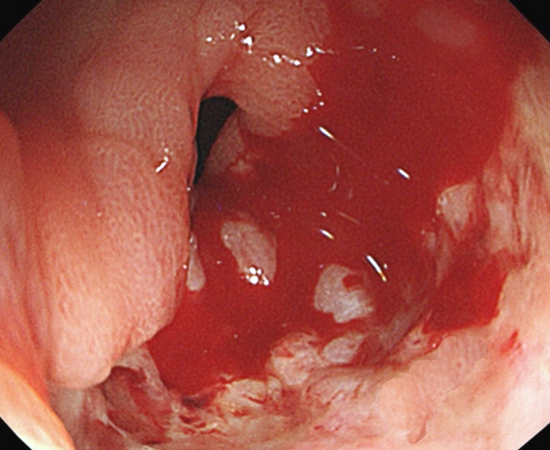Suspect you have a bleeding ulcer?
Don’t ignore these symptoms – they could prove fatal….
Recognizing the signs and symptoms of a bleeding ulcer early can be a lifesaver. You may be completely unaware you even have an ulcer because you are not experiencing any ulcer-related pains. For most ulcer sufferers, this may seem like a painless and easy situation to be in. But in fact, it is a potentially lethal problem!

Your own blood can become a dangerous painkiller..
When an ulcer starts bleeding, your blood neutralizes the stomach acid around the area of the ulcer, when this happens the neutralized stomach acid will not ‘burn’ the raw areas around the ulcer. Basically, this means that you will not feel any pain. And, of course, this can present some serious problems.
If any of the following symptoms of a bleeding ulcer present themselves, we urge you to move swiftly towards getting treatment and make sure you tell your doctor about all the symptoms you have.
The symptoms of a bleeding ulcer
- The passing of foul-smelling black, tarry stools could be one of the first symptoms of a gastric ulcer or a duodenal ulcer that has started bleeding
- The presence of dark red blood in your stools
- If your ulcer is already at an advanced stage then repeated and different signs of bleeding can be identified.
- Vomiting of new blood which is bright red in color – this indicates that a gastric ulcer has started bleeding. This will be accompanied by repeated episodes of nausea.
- Unplanned or unexplained weight loss
- Intense and more localized pain in people with penetrating ulcers – the pain may also radiate to your back
- Faintness and dizziness when standing up – this is due to loss of blood. Over a long period of time, you may become anemic and feel weak, dizzy, or tired all the time. This is typical of a slow bleed left untreated.
REMEMBER – if you have been diagnosed with a bleeding ulcer or even if you have the slightest suspicion that you are bleeding from an ulcer, please do not hesitate to get emergency treatment away!
What causes ulcers to start bleeding?
As an ulcer grows it can start eroding into the muscles of the stomach or duodenal wall. On its path of destruction, blood vessels can be damaged with the result that they start bleeding.
Getting the right treatment…
Acid blockers are commonly prescribed to relieve pain but be warned – the relief is very temporary!
About 3 in every 10 people showing the symptoms of a bleeding ulcer will need surgery to stop the bleeding. If the bleeding is severe, then endoscopy is the most common surgical procedure used to stop the bleeding.
A doctor uses an endoscope to cauterize or seal the bleeding vessel using a heated electrical probe or he may close it off by injecting solutions into the bleeding vessel.
Doctors can also easily see the signs of all the different types of bleeding when using an endoscope. Blood clots, active spurting, slow oozing of blood from arteries, as well as swollen blood vessels that are not bleeding yet, can all be detected with the use of an endoscope.
Endoscopy is currently the gold standard for treating bleeding ulcers.
My Bleeding ulcer is gone… *
I have just finished my 27th day with the Matula tea treatment and I must say it is an amazing product. My stomach conditions have changed dramatically. First of all my bleeding ulcer is gone, I have no symptoms whatsoever. No more burning, stomach-churning and always feeling hungry. I do not have to eat 3 times a day and am able to eat a variety of foods. I am most grateful to you and your product. *
Dean B
USANo more pain or bleeding… *
Some four years ago, I was on a business trip to S. Africa – I had a bleeding ulcer, it was really bad at the time, with a lot of blood in the stool. I tried the Matula Tea and on my return to Denmark a couple of days later, I started the 30 days course. After the first week, I already felt a lot better and the pain was far less, after the second week the pain and the bleeding had completely stopped. I completed the course and up to this day, I have had no more pain or bleeding. Thank you and bless you. *
Mr J.G.N
Mors DenmarkBleeding ulcer… doctor was amazed after Matula Tea treatment.. *
In September, last year I was hospitalized for two days with a bleeding ulcer. I was given antibiotics for a 6 weeks period. At the end of the period, the treatment was extended for a further 6 weeks. I then obtained a Matula treatment course from you. After the completion of the herbal tea course, I felt very much better and returned to the hospital for a check-up. The doctor was amazed, how well the ulcers had healed and said he could not even see traces of them. He said no further treatment was necessary. I am feeling very well now and not on any medication. Many thanks to you for helping me. Please send me another treatment course, which I will keep for “just in case”. *
Mr G.O
East LondonOR…
OR…

Bibliography & References
These articles relate to the symptoms of all types of ulcers found in the gastrointestinal tract;
- Laine, L., Jensen, D. M. (2012). Management of patients with ulcer bleeding. The American Journal of Gastroenterology, 107(3), 345-360.
- Tytgat, G. N. J. (1995). Role of Helicobacter pylori in peptic ulcer disease. European Journal of Gastroenterology & Hepatology, 7(1), 79-85.
- Fischbach, W., & Malfertheiner, P. (2018). Helicobacter pylori infection and non-malignant diseases. Helicobacter, 23(Suppl 1), e12528.
- Chey, W. D., & Wong, B. C. (2007). American College of Gastroenterology guideline on the management of Helicobacter pylori infection. The American Journal of Gastroenterology, 102(8), 1808-1825.
- Peterson, W. L. (1991). Helicobacter pylori and peptic ulcer disease. New England Journal of Medicine, 324(15), 1043-1048.
- Thompson, A. B. R., & Barkun, A. N. (2005). Peptic ulcer disease: recurrence and long-term management. BMJ, 330(7491), 61-63.
- Sonnenberg, A. (2013). Review article: historic changes of Helicobacter pylori-associated peptic ulcer disease. Alimentary Pharmacology & Therapeutics, 38(4), 329-342.
- Lanas, A., & Chan, F. K. (2017). Peptic ulcer disease. The Lancet, 390(10094), 613-624.
- Sleisenger, M. H., Fordtran, J. S., Feldman, M., & Scharschmidt, B. F. (1998). Gastrointestinal and Liver Disease: Pathophysiology, Diagnosis, Management. Saunders.
- Malfertheiner, P., Chan, F. K., & McColl, K. E. (2009). Peptic ulcer disease. The Lancet, 374(9699), 1449-1461.


